

Q&A, Marie-José Montpetit, MIT research scientist and social TV maven. Dr.

Montpetit, who works in MIT’s Research Laboratory of Electronics, was among the experts and influencers we talked with for our May trend report, “10 Ways Marketers Are Using the Second Screen.” One of her interests is social TV—using technology to connect disparate viewers—which Montpetit was thinking about well before it became a hot topic. In her classes, the so-called “matriarch of social TV” has had students develop specific ideas around this concept. She talked to us about some of the more interesting ones they’ve come up with and explained why we’re still in the early stages of realizing the potential of social TV.
Survey reveals social TV's unexpected impact on live TV viewing. The findings of TV Guide Digital's February 2012 survey reveal that less people are watching television content on time-delay or streaming to avoid spoilers they might encounter when using their social networks.
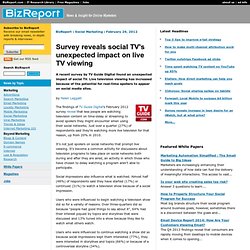
Just over a quarter (27%) of respondents said they're watching more live television for that reason, up from 20% in 2010. Teenagers 'prefer social media to TV' Twitter trends changing live TV. Les nouveaux salons numériques de la conversation : Social TV vs. TV connectée. Social TV vs. TV connectée, deuxième partie. Nous avons vu dans la première partie de ce post le double « double mouvement », entre TV et conversation, et réseau sociaux et contenu.

On pressent que l’on a besoin d’intégration. Qui va apporter une solution innovante, fusionnant objet télévision et conversation, conversation et contenu ? Intermedia – The Next Phase In Consumer Engagement. If you’ve be reading my blog for the last couple of weeks you know I’ve been keenly interested in the development of Social TV.
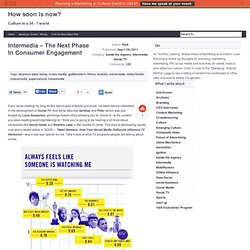
And while sites like GetGlue and Philo (which was just bought by Local Response) got things kicked off by allowing you to “check-in” to the content you were reading/watching/listening to, I think you’re going to be hearing a lot more about companies like Social Guide and Bluefins Labs in the months to come. Social TV – Past, Present and Future Pt. 4. I’m going to wrap up my series on Social TV (Read parts 1, 2 & 3)with a deep dive into three brands who are helping to shape this new territory.

Think Tank: Social media and TV need not be enemies. TV and social media are complementary. Report: Social TV. Comprehensive analysis of the Social TV market.
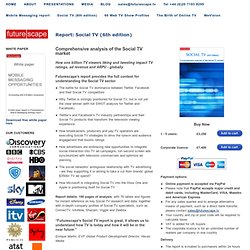
The Social TV Decision Engine. Social Media and TV – Who’s Talking, When and What About? Social media continues to influence how consumers interact with brands and share content every day.
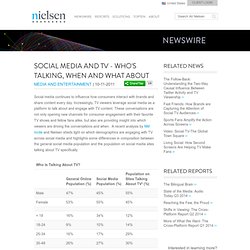
Increasingly, TV viewers leverage social media as a platform to talk about and engage with TV content. These conversations are not only opening new channels for consumer engagement with their favorite TV shows and fellow fans alike, but also are providing insight into which viewers are driving the conversations and when. A recent analysis by NM Incite and Nielsen sheds light on which demographics are engaging with TV across social media and highlights some differences in composition between the general social media population and the population on social media sites talking about TV specifically. Want to make a show more social? Start with the script — Online Video News. Facebook says TV shows should be using Facebook Places check-ins. Facebook's Christian Hernandez Gallardo wants the TV industry to think of Facebook as a platform for distributing content.
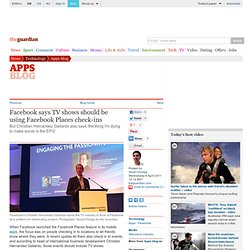
Photograph: Stuart Dredge for the Guardian When Facebook launched the Facebook Places feature in its mobile apps, the focus was on people checking in to locations to let friends know where they were. A recent update let them also check in to events, and according to head of international business development Christian Hernandez Gallardo, those events should include TV shows. Speaking at the Connected Creativity Forum in Cannes on Wednesday, he described the new feature as giving people the ability to check in to "a time and place", and said that broadcasters and TV producers should "think about having a time and a place around every single episode of your series".
"You begin to create these hubs where you can take the passionate screaming and bring them together, because you realise that 10 of your friends are watching Top Gear at the same time," he said. The impact of Twitter on TV shows. Not so very long ago television producers and film-makers were thrilled if their projects had the "water cooler effect" – that is to say the show, the programme or the film became a topic of conversation or chatter among people in offices, bars or the home.
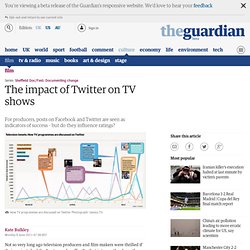
Nowadays the conversations with the most clout are increasingly taking place among social network communities gathering online to take the "water cooler effect" into the twittersphere and on to the many pages of Facebook. A programme that is trending on Twitter is increasingly a currency of success or failure. Do enough people "like" your show on Facebook? Well, if not, then why not? And will your programme be a recommended "must watch" on the growing number of social network-style online television guides, such as the one offered on Freeview. "Producers watch Twitter as their shows are going out with some trepidation," says Simon Nelson, a former controller of BBC Vision and now an adviser to a variety of media companies.
You’ll Never Watch TV Alone Again. How Twitter saved event TV. I couldn't tweet during William and Kate's nuptials last year.
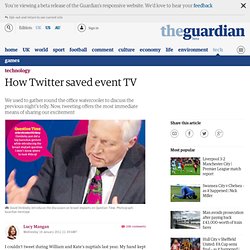
My hand kept reaching for the BlackBerry I had left at a friend's house the night before and finding nothing. History was unfolding before me and I had no one with whom to share my vital thoughts about Princess Beatrice's hat, Kate's dress or Pippa Middleton's bride-upstaging bottom. Well, apart from my sister, parents and the two old family friends who were watching it with me, but really, what's chatting to a handful of real people compared with being part of a community of millions enthusiastically forming itself under the #RoyalWedding hashtag?
I felt like Robinson Crusoe before he even met Man Friday. The phenomenon is too new for any official research to have been carried out, but anecdotal evidence suggests I am not alone in finding that Twitter has become embedded in my TV viewing (non-) life. The notional Paxman's point is valid. This early era of genial, unforced bonhomie may, however, be coming to an end. The Race For The Second Screen: Five Apps That Are Shaping Social TV. It’s easy to understand why 2012 is shaping up to be the year of social TV. Consumers are turning to the so-called second screen like never before. A 2011 whitepaper prepared by Yahoo/Nielsen reported that as many as 86 percent of viewers use mobile devices while watching TV. While many think that number might be high, it signals a trend in consumer behavior that cannot be ignored. Broadcasters and marketers are feeling the heat of both risk and reward.
Risk if they do nothing and cede the second screen to Twitter and Angry Birds; reward if they find a way to deliver companion experiences, drive engagement--and expand ad inventory. One result has been investment flowing into social TV apps, in what some--like MIT research scientist Marie-Jose Montpetit--are already comfortable calling a bubble.
"2012 is the year that people will think, rightly maybe, that they will make a lot of money out of social television, for the first time ever,” she says. The Race for the Second Screen: The Show's the Thing. "There are players out there, obviously, that want to have an app across all of television," says Dermot McCormack, executive vice president of digital media for the MTV Networks Music & Logo Group. "We think that advantage we have is, very simply put, we know what happens next. " One-app-to-rule-them-all solutions, like those discussed in the first part of this series, envision companion platforms that range across users’ TV watching experience. Three Lessons for Social TV - Amy Jo Martin.
By Amy Jo Martin | 1:49 PM February 7, 2012 You may have noticed something was missing throughout the nation’s most social sporting event of the year. The Super Bowl in-game broadcast had zero social media TV integration. With more than a billion people on Facebook and Twitter alone, many of them watching the game, this was a missed opportunity.
Why did NBC and the NFL miss the boat? Likely, the common internal social media struggles got in the way. But while the network and league lost an opportunity to innovate the viewing experience, many advertisers took advantage of integrating social media within their pricey ads. Slapping Twitter handles and Facebook URLs on the TV screen, however, is no longer enough for socially-savvy television.